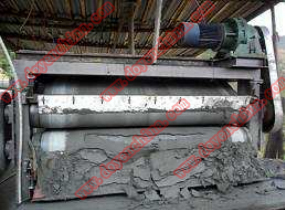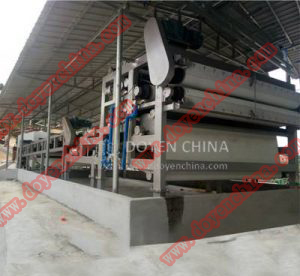

Tel:
+86-757-8633-0278
Email:doyen@doyenchina.com
Fax:+86-757-86287390
Address:Room 201, Building No. 24, Yicui Rose Garden, No. 2, Jihua 7 Road, Chancheng District, Foshan City, Guangdong Province, China 528000.
Calculation of the processing capacity of the belt-type thickening filter press 2.1 The first calculation method of the processing capacity of the belt-type filter press takes the thickness of the wet cake produced by the belt filter as the main calculation parameter, and then calculates based on the calculated output of the wet cake The output feed volume (ie processing capacity), its calculation formula is as follows: Q wet mud cake = B·ξ·δ·v·s·γ·β where: Q wet mud cake——wet mud cake output t/ hB——filter belt width mξ——filter belt width utilization coefficient, generally 0.85~0.9δ——wet mud cake thickness m, generally 6~10mm (0.006~0.01m) v—— actual working speed of filter belt m/min, generally 3~6m/mins—— 60min/h per unit time γ—— wet mud cake specific gravity t/m3, generally 1.03 t/m3β—— solid phase recovery rate, generally ≥95% Q feed rate = (Solid content of wet mud cake/solid content of feed) × Q wet mud cake (t/h) From the above calculation formula, it can be seen that the calculation method is based on the thickness of the wet mud cake produced by the belt filter press The main calculation parameters, and the formation of the thickness of the wet sludge cake is largely related to the operating parameters of the belt filter press, such as the operating speed of the filter belt and the filtration pressure; on the other hand, it is also related to the properties of the sludge such as solid concentration, viscosity, The specific resistance of the sludge after dosing and conditioning is also very related; the formation of the thickness of the wet sludge cake also depends on the structural design of the filter press, such as the length of the concentration section, the capacity of the concentration section, the filtration time and the filtration cycle, Selection of air permeability of the filter belt, etc. In the calculation formula, Q wet mud cake has a linear relationship with the thickness of wet mud cake δ. The thickness of wet mud cake can be selected in the range of 3-10mm, and the thickness of wet mud cake formed during actual operation of many belt filter presses is within the width of the filter belt Not even. Therefore, the author believes that this calculation method is not combined with the main technical parameters of the thickening section and the squeezing section and the main properties of the sludge, and it does not reflect the sludge dosing conditioning effect, the filter press structure parameter design, and the changes in operating parameters.

The influence of other factors on the processing capacity of the belt filter press, and the calculated Q wet mud cake value range is large, which is generally suitable for the design and selection of the belt filter press, and the optimized structure design of the belt filter press, It is of little significance to guide the operation. 2.2 Another calculation method for the processing capacity of the belt filter press: The sludge dewatering system of urban sewage and industrial wastewater requires dosing and conditioning of the sludge before sludge dewatering. The purpose of dosing conditioning is to improve the dewatering performance of the sludge, reduce the affinity of water in the sludge, and reduce the filtration specific resistance value (ie the resistance of the filter cake) r and the capillary water absorption time CST of the sludge. At the beginning of filtration, the filtrate must overcome the resistance of the filter medium (filter belt). When the filter cake is gradually formed, it must also overcome the resistance of the filter cake itself, which is the basic form of filter cake filtration. The Carman filter basic equation derived from the basic principle of liquid flow through the filter residue layer can be used to calculate the filtration yield (that is, the processing capacity). According to the basic equation of Carmen filtration: (1) where: V—— filtrate volume m3t—— filtration time sP—— filtration pressure PaA—— filtration area m2μ—— dynamic viscosity of filtrate Pa·sω—— filtration per unit volume of filtrate The weight of the dry solids intercepted on the filter medium kg/m3r-specific resistance m/kg, that is, the resistance of the filter cake, defined as the resistance of the filter cake per unit of dry weight per unit filter area Rf-the resistance of the filter medium 1/m2 From the definition of ω, the following formula can be written: (2) where: Q0——the amount of sludge (treatment capacity) m3Qf——the amount of filtrate m3Ck——the concentration of solid matter in the filter cake kg/m3 According to the liquid equilibrium relationship: Q0= Qf + Qk According to the solid phase equilibrium relationship: Q0C0= QfCf+ QkCk: (3) where: C0——solid matter concentration in the raw sludge g/LCf——solid matter concentration in the filtrate g/L, sludge Dehydration system generally requires solid recovery rate ≥95%, Cf value is very small, in actual calculations can be taken Cf = 0Qk-filter cake amount L according to the definition of filtration yield: the weight of the filter biscuit produced on the unit filter area per unit time kg/ (m2·s) or kg/(m2·h). For the convenience of calculation, temporarily set the impedance of the filter medium Rf=0, then the basic equation of Karman filter (1) becomes: (4) Set the weight of the filter biscuit to W, then W=ωV, V=W/ω substitute (4 ) Finished:

Namely: the processing capacity L of the belt filter press (calculated as the absolute dry sludge, that is, the weight of the filter biscuit): (kg/m2.s) (5) (5) is the processing capacity of the belt filter press Another calculation formula. For the sludge dewatering system of a municipal sewage plant, after the sludge is dosing and conditioning, the specific resistance r of the sludge is controlled at (1~4)×1012m/kg (the laboratory determines the more economical dosing amount by measuring the r value) For the belt filter press, the specific impedance r of the sludge after conditioning by the laboratory is (1~3)×1012 m/kg (centrifugal dehydration r=(2~4)×1012 m/kg) . When the ambient temperature is 20°C, the kinematic viscosity of the sludge μ=0.001Pa·s. When using the formula (5) to calculate, the belt filter press should be calculated in two parts: the concentration section and the pressing section. The thickening section is gravity filtration and dehydration. The filtration pressure P is calculated according to the height (average thickness, 1mm=9.5Pa) of the sludge entering the thickening section sludge tank. The concentration C0 is the inlet sludge concentration, and Ck is the sludge concentration out of the thickening section. It is 8-10% (the concentration when the sludge basically loses fluidity after gravity dehydration through the thickening section). The filtration time t is calculated according to the length of the concentration section and the walking speed of the filter belt. For the squeezing section, the pressure P is calculated by the filter belt tension and the contact area between the squeezing roller and the filter belt. The concentration C0 entering the squeezing section is the sludge concentration (8-10%) of the thickening section, and Ck is the final filter cake concentration (25 %~20%), filter press time t=m/T, m=ts/T (ie t=ts/T2), ts is the actual filter press time (the contact length between the filter belt of the press section and the press roller, the filter belt of the press section Calculated by operating speed), T is the filter press cycle (operating time of the press section). The sum of the processing capacity of the thickening section and the pressing section is the processing capacity of the belt filter press. Because the impedance Rf of the filter belt of the filter medium is not considered in the calculation, and the impedance Rf of the filter belt is related to the material of the filter belt and the air volume [usually choose 8000~10000m3/(h·m2)], etc., the final processing capacity is Should be the processing capacity calculated above multiplied by a coefficient K (K is generally 0.9 ~ 0.95) is the processing capacity of the belt filter press. 3. Conclusion Although the second calculation method is more complicated than the first calculation method, the calculation method includes the influence of belt filter press structure design parameters, sludge property parameters, operating parameters, etc. The structure design of the belt filter press, the reasonable dosage of the dosing and the selection of operating parameters have certain guiding significance for increasing the processing capacity of the belt filter press. And calculated by examples, the processing capacity of the concentration section plays a major role in the processing capacity of the belt filter press.

Doyen specializes in providing belt press equipment for the Southeast Asian market. Welcome to visit our workshop and formulate a more scientific plan based on the actual situation of your company. Welcome to visit joyce@doyenchina.com or visit https://www.doyenchina.com.
Dec-26-2020
admin

 +86-757-8633-0278
+86-757-8633-0278 doyen@doyenchina.com
doyen@doyenchina.com Sitemap
Sitemap